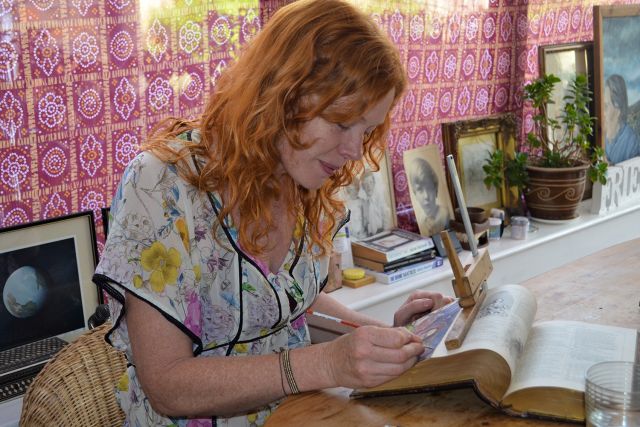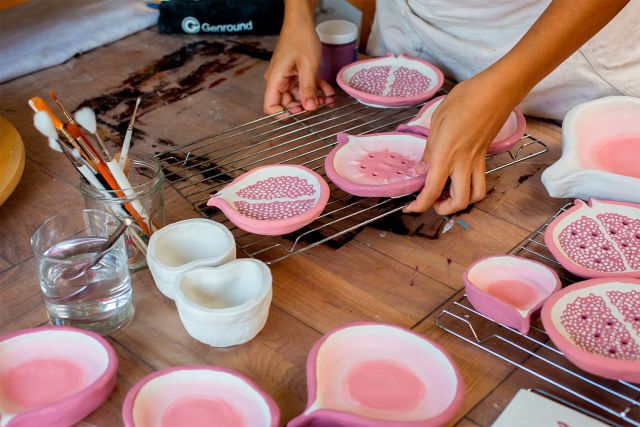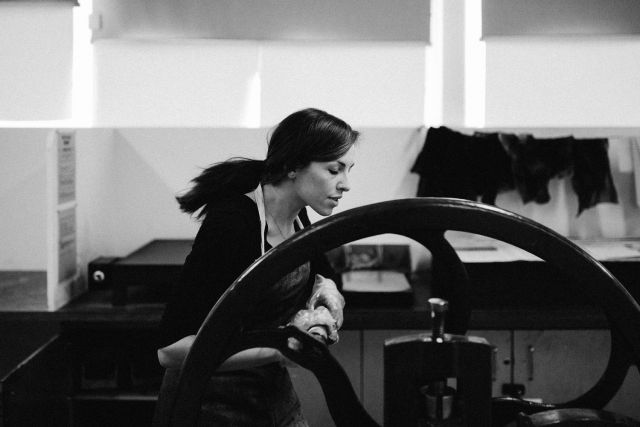Clare has decorated the edge of this antique book with watercolour sketches of Japanese erotic scenes. To do this she used the dying art of fore-edge painting, a type of book decoration in which watercolour decorations are painted inside the page edge and are only visible when the book is open or the pages fanned.
 DSC_0042.JPG.jpeg)
 Clare Brooksbank, Photo by Nicolò Zanatta © Michelangelo Foundation (2)_1788632.jpg.jpeg)

 DSC_0023.jpg.jpeg)
Clare Brooksbank
- Fore-edge painter
- Derby, United Kingdom
- Master Artisan
- Recommended by Crafts Council UK
Continuing a hidden craft
- • Clare paints watercolours on the fore-edges of books
- • She paints by eye, without drawing a design first
- • This historic English tradition is now a rare craft
Artist Clare Brooksbank was in her early 20s when her work at the time – miniature oil paintings on a doll’s house scale – was spotted by a prominent antiquarian book dealer who thought she had the delicate touch necessary to become a fore-edge painter. As someone who loved books and had “an obsession with painting detail”, this historic English tradition suited Clare, and over the years she has created more than 2,000 of these ‘hidden’ watercolours painted on the fanned front edge of gilded antique books. Now one of only two commercial fore-edge painters in the UK, she combines her artistic work with teaching yoga.
Read the full interviewWorks
Photo: © Clare Brooksbank

Photo: © Clare Brooksbank
The edge of this large leather-bound book of Shakespeare’s works has been decorated with a watercolour twin fore-edge painting. A fore-edge painting is a type of book decoration in which watercolour decorations are painted inside the page edge and are only visible when the book is open or the pages fanned. On the left is a scene from A Midsummers Night’s Dream, the middle section features the Globe Theatre where Shakespeare’s plays were performed, and on the right is a scene from The Merchant of Venice.

Photo: © Clare Brooksbank
The scene for this watercolour fore-edge painting was based on John Keats’ narrative poem Isabella, or the Pot of Basil. Written in 1818, the poem recounts the story of a young girl whose family has arranged to have her married to a rich merchant but who is herself in love with her brother’s employee. The poem was a popular theme among Pre-Raphaelite painters. A fore-edge painting is a type of book decoration in which watercolour decorations are painted inside the page edge and are only visible when the book is open or the pages are fanned.

Photo: © Clare Brooksbank
This watercolour fore-edge painting was based on Shakespeare's play, The Tempest. The style of the painting was influenced by the works of the Pre-Raphaelite painters. In this scene, Miranda, the sorcerer’s daughter, looks out over a tumultuous and agitated sea. A fore-edge painting is a type of book decoration in which watercolour decorations are painted inside the page edge and are only visible when the book is open or the pages are fanned.














